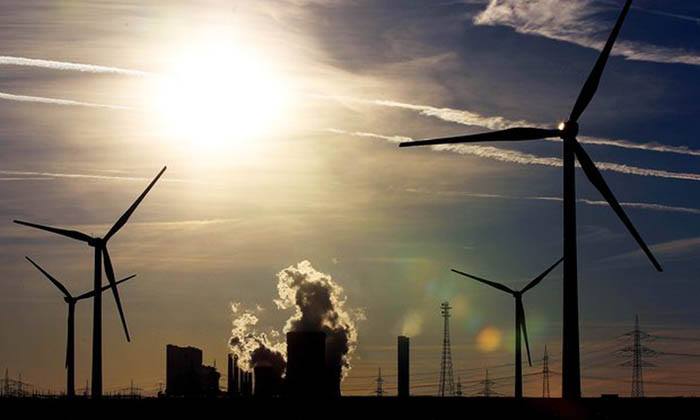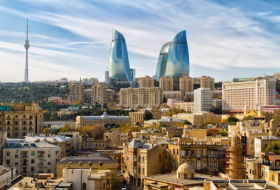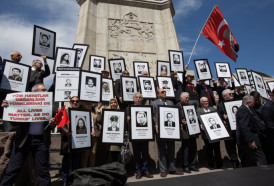By Leyla Jabbarzade
Edited by Sabina Hasanova
In this study, we mainly focused on the exploration of nuclear power plants and threats they pose.
Clearly, we use energy for almost everything - for cooking, catching a bus, turning the light and so on (McLeish, 2007). Energy can be obtained from different sources such as oil, gas and nuclear power. Nuclear power is the most used source to get energy. However, nuclear power is an inherently dangerous activity. Jim Riccio, Greenpeace`s Nuclear Policy Analyst states that splitting atoms is the most complicated and dangerous way to produce electricity. Additionally, each nuclear reactor has the potential to devastate the region in which it operates. The potential for such devastation lies in the radioactive fuel that fires the nuclear power plant.
The radioactive fuel rods, whether inside the reactor or in the spent fuel pool, must be cooled to prevent them from melting down. If a meltdown were to occur in either the reactor or the spent fuel pool, the accident could kill and injure tens of thousands of people, cost billions of dollars in damages and leave large regions uninhabitable.
In the years following the major accidents at Three Mile Island in 1979 and Chernobyl in 1986, nuclear power fell out of favour, and some countries applied the brakes to their nuclear programs (Moniz, 2011). Consequently, zeal for nuclear energy has fizzled. The catastrophic risks of nuclear energy—like the meltdowns of nuclear reactors in Japan or Ukraine—far outweigh the potential benefits.
However, Armenia keeps on using the Metsamor NPP which commenced operation in 1980 and expired in 2001. Energy is Armenia`s excuse for the operation of Metsamor NPP. However, it is the most expensive and dangerous way of energy production.
In this fashion, renewable energy sources such as wind and solar energy can be suggested to provide the country with both energy and security. Renewable energy is better for the environment, the economy, and doesn’t come with the risk of a nuclear meltdown.
The following paragraphs will clearly define nuclear materials, nuclear power plants, nuclear reactors, nuclear energy, dangers of NPPs, Chernobyl disaster and dangers of Metsamor NPP of Armenia.
Nuclear materials
"Nuclear materials" most commonly refers to fissile materials that are capable of sustaining a chain reaction in a process that releases energy called nuclear fission. The materials include isotopes of uranium, thorium, and plutonium. These materials are distinct from radiological materials like cobalt and caesium, which are used for a variety of civilian purposes, including medical procedures.
The nuclear materials most commonly used for nuclear energy and nuclear weapons are uranium and plutonium in various forms.
Nuclear power plants
‘How does a nuclear power plant work?’
Atomic energy has had a mixed history in the half-century or so since the world`s first commercial nuclear power plant opened at Calder Hall (now Sellafield) in Cumbria, England in 1956. Huge amounts of world energy have been produced from atoms ever since, but amid enormous controversy.
What is a nuclear reactor?
A nuclear reactor is a system that contains and controls sustained nuclear chain reactions. Reactors are used for generating electricity, moving aircraft carriers and submarines, producing medical isotopes for imaging and cancer treatment, and for conducting research.
Main components
• The core of the reactor contains all of the nuclear fuel and generates all of the heat. It contains low-enriched uranium (<5% U-235), control systems, and structural materials. The core can contain hundreds of thousands of individual fuel pins.
• The coolant is the material that passes through the core, transferring the heat from the fuel to a turbine. It could be water, heavy-water, liquid sodium, helium, or something else. In the US fleet of power reactors, water is the standard.
• The turbine transfers the heat from the coolant to electricity, just like in a fossil-fuel plant.
• The containment is the structure that separates the reactor from the environment. These are usually dome-shaped, made of high-density, steel-reinforced concrete. Armenian Metsamor does not have containment to speak of.
Fuel, made up of heavy atoms that split when they absorb neutrons, is placed into the reactor vessel (basically a large tank) along with a small neutron source. The neutrons start a chain reaction where each atom that splits releases more neutrons that cause other atoms to split. Each time an atom splits; it releases large amounts of energy in the form of heat. The heat is carried out of the reactor by coolant, which is most commonly just plain water. The coolant heats up and goes off to a turbine to spin a generator or drive shaft. Nuclear reactors are just exotic heat sources.
Cooling towers are needed by some plants to dump the excess heat that cannot be converted to energy due to the laws of thermodynamics. These are the hyperbolic icons of nuclear energy. They emit only clean water vapour.
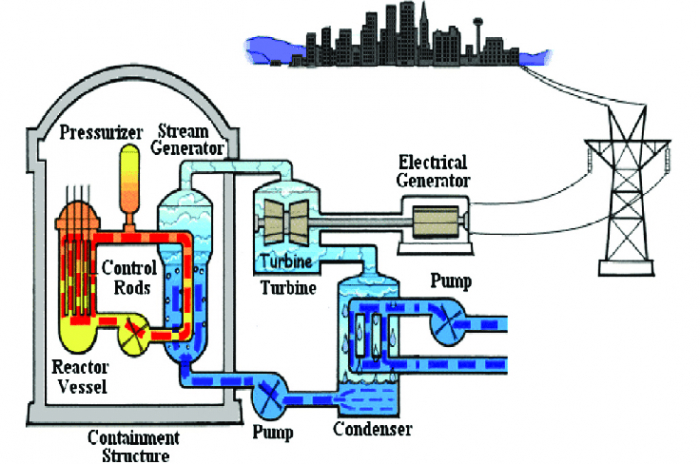
@Researchgate.net
Some people believe nuclear power is a vital way to tackle climate change; others insist it is dirty, dangerous, uneconomic, and unnecessary. Caldicott (2013) also states that it is a very expensive, sophisticated and dangerous way to get energy. It can be said that nuclear energy has no place in a safe, clean, sustainable future inconsistency with Greenpeace. Greenpeace got its start protesting nuclear weapons testing back in 1971.
And just because nuclear pollution is invisible doesn’t mean it’s clean.
Dangers of Nuclear Energy
The two most vulnerable parts of nuclear power facilities are the nuclear reactors and the spent fuel cooling pools. If an airliner crashed into a nuclear reactorís containment structure, the plane could penetrate the structure likely leading to an explosion and fire. Nuclear power plants are not well equipped to deal with severe fires, which could cause several safety systems to fail simultaneously. Such an explosion would result in a substantial release of radioactivity. Obviously, meltdowns like the ones in Fukushima or Chernobyl released enormous amounts of radiation into the surrounding communities, forcing hundreds of thousands of people to evacuate. Many of them may never come back. If the industry’s current track record is such indications, we can expect a major meltdown about once per decade.
The release of radioactivity can result in a variety of devastating health and environmental effects. Acute exposure to radiation can cause radiation sickness, the symptoms of which include nausea, weakness, hair loss, skin burns and progressive loss of organ function. Chronic exposure to lower levels of radiation results in genetic mutations.
According to the research, tens of millions of people would die, global temperatures would crash and most of the world would be unable to grow crops for more than five years after a conflict.
Furthermore, the ozone layer, which protects the surface of the Earth from harmful ultraviolet radiation, would be depleted by 40% over many inhabited areas and up to 70% at the poles.
Alan Robock, an American climatologist, the co-author of the study, told Guardian Unlimited: "Nuclear weapons are the greatest environmental danger to the planet from humans, not global warming or ozone depletion."
There are around 30,000 nuclear warheads worldwide, 95% of which are held by the US and Russia.
The scientists said a sudden change to the Earth`s ecosystem because of nuclear blasts would be worse than any of the effects predicted by global warming due to greenhouse gases. Prof Robock stated, "Global warming is a problem and we certainly should address it but in 20 years, the temperature might go up by a few tenths of a degree and it will be gradual”.
There is still no safe, reliable solution for dealing with the radioactive waste produced by nuclear plants. Beyond the risks associated with nuclear power and radioactive waste, the threat of nuclear weapons looms large. The spread of nuclear technology and nuclear weapons is a threat to national security and the safety of the entire planet. However, the IAEA nuclear security series (2015) highlights that the IAEA’s principal objective under its Statute is “to accelerate and enlarge the contribution of atomic energy to peace, health and prosperity throughout the world.”
Nuclear Energy’s True Costs
Nuclear energy isn’t just bad for the environment; it’s bad for our economy.
Nuclear power plants are expensive to build, prompting Wall Street to call new nuclear a “bet the farm” risk. Every nuclear plant under construction in the U.S. is well behind schedule and at least $1 billion over budget.
This is even before taking into account the astounding cleanup and health costs caused by radioactive waste pollution and nuclear meltdowns. Cleaning up Fukushima, if ever possible, will cost at least $100 billion and could be more than double that.
Why invest money in a dangerous, unsustainable form of energy when we can have clean, renewable energy for less?
Below are nuclear power plant accidents and incidents with multiple fatalities and/or more than US$100 million in property damage occurring between 1952-2011 ( Altikat, et al., 2015, p. 2060).
• Mayak, Kyshtym, Russia (September 29, 1957); The Kyshtym Nuclear disaster was a radiation contamination incident that occurred at Mayak, a Nuclear fuel reprocessing plant in the Soviet Union.(INES Level 6)
• Sellafield, Cumberland, United Kingdom (October 10, 1957); A fire at the British atomic bomb project destroyed the core and released an estimated 750 terabecquerels (20,000 curies) of radioactive material into the environment. (No death, INES Level 5)
• Idaho Falls, Idaho, United States (January 3, 1961); Explosion at SL-1 prototype at the National Reactor Testing Station. All 3 operators were killed when a control rod was removed too far. (3 death, 22 millions US$ costs, INES Level 4)
• Frenchtown Charter Township, Michigan, United States (October 5, 1966); Partial core meltdown of the Fermi 1 Reactor at the Enrico Fermi Nuclear Generating Station. No radiation leakage into the environment. (No death, 132 millions US$ costs)
• Lucens reactor, Vaud, Switzerland (January 21, 1969); It suffered a loss-of-coolant accident, leading to a partial core meltdown and massive radioactive contamination of the cavern, which was then sealed.(No death, INES Level 4)
• Sosnovyi Bor, Leningrad Oblast, Russia (1975); There was reportedly a partial nuclear meltdown in Leningrad nuclear power plant reactor unit 1.
• Greifswald, East Germany (December 7, 1975); Electrical error causes fire in the main trough that destroys control lines and five main coolant pumps. (No death, 443 millions US$ costs, INES Level 3)
• Jaslovské Bohunice, Czechoslovakia (January 5, 1976); Malfunction during fuel replacement. Fuel rod ejected from the reactor into the reactor hall by coolant (CO2). (2 death, INES Level 4)
• Jaslovské Bohunice, Czechoslovakia (February 22, 1977); Severe corrosion of reactor and release of radioactivity into the plant area, necessitating total decommission. (No death, 1,700 millions US$ costs, INES Level 4)
• Three Mile Island, Pennsylvania, United States (March 28, 1979); Loss of coolant and partial core meltdown due to operator errors. There is a small release of radioactive gases. (No death, 2,400 millions US$ costs, INES Level 5)
• Athens, Alabama, United States (September 15, 1984); Safety violations, operator error, and design problems force a six-year outage at Browns Ferry Unit 2. (No death, 110 millions US$ costs)
• Athens, Alabama, United States (March 9, 1985); Instrumentation systems malfunction during startup,which led to suspension of operations at all three Browns Ferry Units. (No death, 1,830 millions US$ costs)
• Plymouth, Massachusetts, United States (April 11, 1986); Recurring equipment problems force emergency shutdown of Boston Edison’s Pilgrim Nuclear Power Plant. (No death, 1,001 millions US$ costs)
• Chernobyl disaster, Ukrainian SSR (April 26, 1986); Overheating, steam explosion, fire, and meltdown, necessitating the evacuation of 300,000 people from Chernobyl and dispersing radioactive material across Europe. (56 direct death, 4,000 to 985,000 cancer, 6,700 millions US$ costs, INES Level 7)
How many people has Chernobyl killed so far? We’ll probably never know. Statistically, the deaths are undetectable.
• Hamm-Uentrop, Germany (May 4, 1986); Experimental THTR-300 reactor releases small amounts of fission products (0.1 GBq Co-60, Cs-137, Pa-233) to surrounding area. (No death, 267 millions US$ costs)
• Delta, Pennsylvania, United States (March 31, 1987); Peach Bottom units 2 and 3 shutdown due to cooling malfunctions and unexplained equipment problems. (No death, 400 millions US$ costs)
• Lycoming, New York, United States (December 19, 1987); Malfunctions force Niagara Mohawk Power Corporation to shut down Nine Mile Point Unit 1. (No death, 150 millions US$ costs)
• Lusby, Maryland, United States (March 17, 1989); Inspections at Calvert Cliff Units 1 and 2 reveal cracks at pressurized heater sleeves, forcing extended shutdowns. (No death, 120 millions US$ costs)
• Sosnovyi Bor, Leningrad Oblast, Russia (March 1992); An accident at the Sosnovy Bor nuclear plant leaked radioactive gases and iodine into the air through a ruptured fuel channel.
• Severesk, formerly Tomsk-7, Russia (April 6, 1993); A tank at a uranium and plutonium factory inside the plant explodes, resulting in radioactivity being dispersed into the atmosphere contaminating an area of over 120 sq km. A number of villages are evacuated and left permanently uninhabitable. (INES Level 4).
• Waterford, Connecticut, United States (February 20, 1996); Leaking valve forces shutdown Millstone Nuclear Power Plant Units 1 and 2, multiple equipment failures found. (No death, 254 millions US$ costs)
• Crystal River, Florida, United States (September 2, 1996); Balance-of-plant equipment malfunction forces shutdown and extensive repairs at Crystal River Unit 3. (No death, 384 millions US$ costs)
• Ibaraki Prefecture, Japan (September 30, 1999); Tokaimura nuclear accident killed two workers, and exposed one more to radiation levels above permissible limits. (2 death, 54 millions US$ costs, INES Level 4)
• Oak Harbor, Ohio, United States (February 16, 2002); Severe corrosion of control rod forces 24-month outage of Davis-Besse reactor. (No death, 143 millions US$ costs, INES Level 3)
• Fukui Prefecture, Japan (August 9, 2004); Steam explosion at Mihama Nuclear Power Plant killed 4 workers and injured 7 more. (4 death, 9 millions US$ costs, INES Level 1)
• Forsmark, Sweden (July 25, 2006); An electrical fault at Forsmark Nuclear Power Plant caused one reactor to be shut down. (No death, 100 millions US$ costs, INES Level 2)
• Fukushima, Japan (March 11, 2011); A tsunami flooded and damaged the 5 active reactor plants drowning two workers. Loss of backup electrical power led to overheating, meltdowns, and evacuations. One man died suddenly while carrying equipment during the clean-up. (2 direct death, results unknown, INES Level 7)
• Marcoule, France (September 12, 2011); One person was dead and four injured, one seriously, in a blast at the Marcoule. The explosion took place in a furnace used to melt metallic waste.
Armenian (Metsamor) NPP
Metsamor Nuclear Power Plant (Armenian Nuclear Power Plant-ANPP) in Metsamor, Armenia, is 16 km away from Igdir, located at the east of Turkey, and is a facility that meets 40% of Armenia`s energy needs. It is approximately 80 km to Iran, 110 km to Georgia and 50 km to Nakhchivan, Azerbaijan.
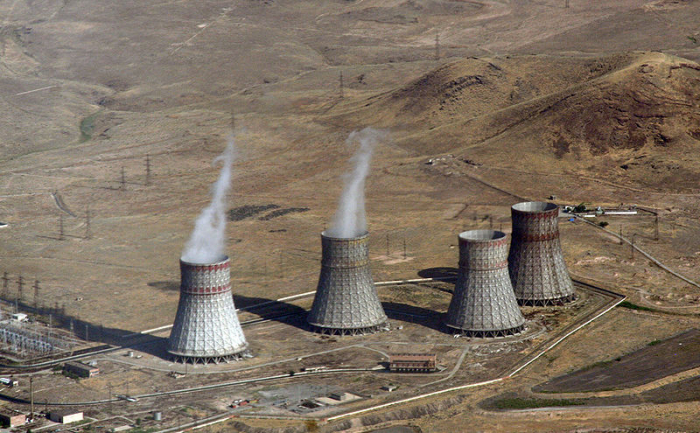
@EjAtlas
Technical Features of ANPP
The Armenian NPP Unit process flow diagram consists of two circuits. The primary circuit is radioactive and includes a WWER-440 reactor and six circulation cooling loops. Each loop comprises one reactor coolant pump (RCP), steam generator and two main loop isolation valves. A pressurizer is connected to one of the circulation loops of the primary circuit to maintain the designed pressure of water acting as a coolant of reactor and neutron moderator, at the same time.
The secondary circuit is not radioactive. It comprises steam generators, streamlines, steam turbines, separator –reheaters, feed-water pumps, deaerators and regenerative heaters.
A steam generator is a common component for primary and secondary circuits. The heat energy generated in the reactor is transferred in the steam generator via its heat exchanging tubes from the primary circuit to the secondary circuit. Saturated steam generated in a steam generator is supplied by streamlines to the turbine driving the generator rotation for a generation of electric current.
The NPP‘s danger
The Metsamor NPP is situated on an active seismic fault; the site of a devastating earthquake killed more than 50,000 people in 1988. Armenia signed a Partnership and Cooperation Agreement (PCA) with the European Commission promising to shut down Metsamor by 2004 (Meredith, 2014). Nevertheless, the plant was in extremely poor condition that made its operation unsecure and dangerous. The decision to restart the operation of the NPP led to the fears of another Chernobyl as it suffered from the same deficiencies in all early Soviet-designed reactors such as poor management, insufficient fire control, outdated computers, lax training, bad construction and not containment structure to prevent catastrophic release of radiation in the likely event of an accident (Meredith, 2014).
In addition to its ageing technology, Metsamor, high in the mountains, lacks suitable water resources to use as reactor core coolant in the event that an earthquake damaged the facility, while Armenia’s parlous fiscal situation means that its government lacks financial resources to address the consequences of a possible accident.
Metsamor is one less than a half dozen remaining nuclear reactors of its kind that were built without primary containment structures.
Furthermore, Caldicott, (2013) contends that NPPs are atomic bomb factories. Moreover, Wilson Clark and John McCosker (1980) contend, “Since nuclear power plants constitute less than 200 potential targets . . . and have the added risk in some cases of being very close to population centers, they are prime candidates for strategic nuclear targeting or conventional bombing”(p. 30).
In this regard, it can be argued that Metsamor power plant can be used for inviting assault by plane, truck, bombs, armed attack and nuclear smuggling in this age.
The latest nuclear smugglings by Armenians once more support the above-mentioned argument on the NPP.
The Metsamor NPP was studied for several times to demonstrate its possibility of accidents in terms of old technology and unsatisfactory safety measures, a location which is prone to earthquake and damages to biodiversity. If an accident happens, it will severely influence Turkey, Azerbaijan, Georgia, Iran and Armenia itself. However, Armenia still keeps on operating the Metsamor NPP excusing energy need of the country.
The nuclear age is over and the age of renewables has begun.
It must be noted that new nuclear plants are more expensive and take longer to build than renewable energy sources like wind or solar. Nuclear energy is diverting attention and investment from the sustainable energy solutions we need.
It’s time to stop building new nuclear facilities, phase out the ones that exist, and focus on clean energy for the future. If we are to avoid the most damaging impacts of climate change, we need solutions that are fast and affordable. Nuclear power is neither. We can do better than trading off one disaster for another.
Click here to access reference list.
AzVision.az








